
Curry is a dish with a sauce or gravy seasoned with spices, mainly derived from the interchange of Indian cuisine with European taste in food, starting with the Portuguese, followed by the Dutch and British, and then thoroughly internationalised. Many dishes that would be described as curries in English are found in the native cuisines of countries in Southeast Asia and East Asia.

Malaysian cuisine consists of cooking traditions and practices found in Malaysia, and reflects the multi-ethnic makeup of its population. The vast majority of Malaysia's population can roughly be divided among three major ethnic groups: Malays, Chinese and Indians. The remainder consists of the indigenous peoples of Sabah and Sarawak in East Malaysia, the Orang Asli of Peninsular Malaysia, the Peranakan and Eurasian creole communities, as well as a significant number of foreign workers and expatriates.

Laksa is a spicy noodle dish popular in Southeast Asia. Laksa consists of various types of noodles, most commonly thick rice noodles, with toppings such as chicken, prawns or fish. Most variations of laksa are prepared with a rich and spicy coconut curry soup or a broth seasoned with asam.
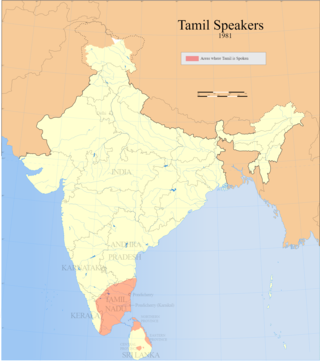
Tamil cuisine is a culinary style of Tamil people originating in the southern Indian state of Tamil Nadu and neighboring Sri Lanka. Meats, along with rice, legumes, and lentils, are popular. Dairy products and tamarind are used to provide sour flavors. On special occasions, traditional Tamil dishes are served in a traditional manner, using banana leaves in place of utensils. After eating, the banana leaves are then used as a secondary food for cattle. A typical breakfast meal consists of idli or dosa with chutney. Lunch includes rice, sambar, curd, kuzhambu, and rasam.

Singaporean cuisine is derived from several ethnic groups in Singapore and has developed through centuries of political, economic, and social changes in the cosmopolitan city-state.
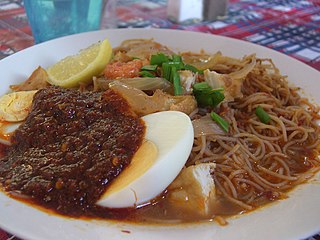
Mee siam is a dish of thin rice vermicelli of hot, sweet and sour flavours, originated in Penang but popular among the Malay and Peranakan communities throughout Peninsular Malaysia and Singapore, although the dish is called "Siamese noodle" in Malay and thus appears to be inspired or adapted from Thai flavours when Thailand was formerly known as Siam. Mee siam is related to kerabu bee hoon although there is a significant difference in the recipe.

Burmese cuisine encompasses the diverse regional culinary traditions of Myanmar, which have developed through longstanding agricultural practices, centuries of sociopolitical and economic change, and cross-cultural contact and trade with neighboring countries at the confluence of Southeast Asia, East Asia, and South Asia, such as modern-day nations of Thailand, China, and India, respectively. Mohinga, a savory fish soup with lemongrass and banana leaves are eaten for breakfast with rice noodles, lunch is rice accompanied with small side dishes of vegetables, a small soup and a meat or fish dish. Dinner is consumed in a similar fashion to lunch. Burmese stews or curries are not Indian curries but milder with reliance on the trio of onion garlic and ginger to create savory gravies. Burmese food does not rely heavily on coconut such as in Thai cuisine. Burmese however enjoy spicy food with addition of chilis mixed into the dishes.
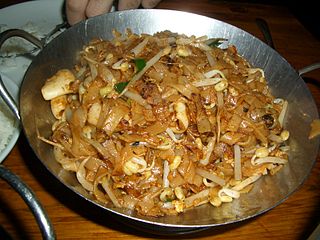
Malaysian Chinese cuisine is derived from the culinary traditions of Chinese Malaysian immigrants and their descendants, who have adapted or modified their culinary traditions under the influence of Malaysian culture as well as immigration patterns of Chinese to Malaysia. Malaysian Chinese cuisine is predominantly based on an eclectic repertoire of dishes with roots from Fujian, Cantonese, Hakka and Teochew cuisines.

Noodle soup refers to a variety of soups with noodles and other ingredients served in a light broth. Noodle soup is a common dish across East Asia, Southeast Asia and the Himalayan states of South Asia. Various types of noodles are used, such as rice noodles, wheat noodles and egg noodles.
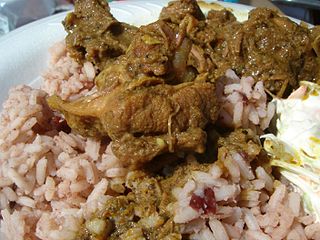
Goat curry, curried goat, or curry goat is a curry dish prepared with goat meat, originating from the Indian subcontinent. The dish is a staple in Southeast Asian cuisine, Caribbean cuisine, and the cuisine of the Indian subcontinent. In the Caribbean and Southeast Asia, the dish was brought to the region by the Indian diaspora, and has subsequently influenced the respective local cuisines. This dish has also spread throughout the Indo-Caribbean diaspora in North America and Europe.

Peranakan cuisine or Nyonya cuisine comes from the Peranakans, descendants of early Chinese migrants who settled in Penang, Malacca, Singapore and Indonesia, inter-marrying with local Malays. In Baba Malay, a female Peranakan is known as a nonya, and a male Peranakan is known as a baba. The cuisine combines Chinese, Malay, Javanese, South Indian, and other influences.

Thai curry is a dish in Thai cuisine made from curry paste, coconut milk or water, meat, seafood, vegetables or fruit, and herbs. Curries in Thailand mainly differ from the curries in India in their use of ingredients such as fresh rhizomes, herbs, and aromatic leaves rather than a mix of dried spices.
Ohn no khao swè is a Burmese dish consisting of wheat noodles in a curried chicken and coconut milk broth thickened with gram flour. It features wheat noodles in a rich broth made with curried chicken and coconut milk, thickened with gram flour. Crispy fried bean fritters, hard-boiled eggs, sliced raw onions, chili peppers, and crispy noodles are added to the dish. Fish sauce and lime or lemon juice are then drizzled over everything.

Malaysian Indian cuisine, or the cooking of the ethnic Indian communities in Malaysia, consists of adaptations of authentic dishes from India, as well as original creations inspired by the diverse food culture of Malaysia. Because the vast majority of Malaysia's Indian community are of South Indian descent, and are mostly ethnic Tamils who are descendants of immigrants from a historical region which consists of the modern Indian state of Tamil Nadu and Sri Lanka's Northern Province, much of Malaysian Indian cuisine is predominantly South Indian-inspired in character and taste. A typical Malaysian Indian dish is likely to be seasoned with curry leaves and whole and powdered spice, and to contain fresh coconut in various forms. Ghee is still widely used for cooking, although vegetable oils and refined palm oils are now commonplace in home kitchens. Before a meal it is customary to wash hands as cutlery is often not used while eating, with the exception of a serving spoon for each respective dish.

Khanom chin or Khanom jeen are fresh, thin rice noodles in Thai cuisine which are made from rice sometimes fermented for three days, boiled, and then made into noodles by extruding the resulting dough through a sieve into boiling water. Khanom chin is served in many kinds of stock: coconut milk, fish curry, and chilli.

Burmese salads are a diverse category of indigenous salads in Burmese cuisine. Burmese salads are made of cooked and raw ingredients that are mixed by hand to combine and balance a wide-ranging array of flavors and textures. Burmese salads are eaten as standalone snacks, as side dishes paired with Burmese curries, and as entrees. The most common or popular, the iconic laphet thoke is traditionally eaten as a palate cleanser at the end of a meal.
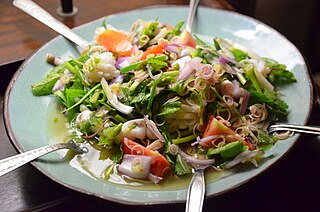
Salads that are internationally known as Thai salads with a few exceptions fall into four main preparation methods. In Thai cuisine these are called yam, tam, lap and phla. A few other dishes can also be regarded as being a salad.
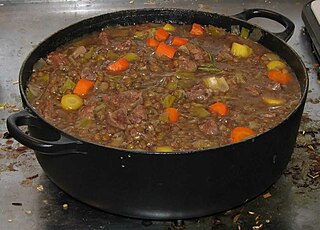
A stew is a combination of solid food ingredients that have been cooked in liquid and served in the resultant gravy. Ingredients can include any combination of vegetables and may include meat, especially tougher meats suitable for slow-cooking, such as beef, pork, venison, rabbit, lamb, poultry, sausages, and seafood. While water can be used as the stew-cooking liquid, stock is also common. A small amount of red wine or other alcohol is sometimes added for flavour. Seasonings and flavourings may also be added. Stews are typically cooked at a relatively low temperature, allowing flavours to mingle.

Kaeng hang le is a rich Northern Thai pork curry. Kaeng hang le is very popular in Northern Thailand, well-known as a specialty of the region. The curry differs from traditional northern Thai curries in several respects: it is typically eaten with long-grained rice, not sticky rice, and uses dried spices, which are commonly used in Burmese, but not northern Thai curries. The dish is commonly served as a festive dish in northern Thailand.




















